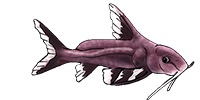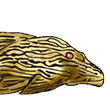asian stinging catfish
-
predatory cat
- Posts: 3
- Joined: 10 Feb 2003, 23:02
- Location 1: Nashville,TN
- Interests: predatory freshwater fish
asian stinging catfish
I'm looking into getting a couple of these guys I'm just looking for some basic information on them how fast to do they grow what do they eat are they aggressive how big do they exactly get can I just get some basic first hand experience information
- Silurus
- Posts: 12489
- Joined: 31 Dec 2002, 11:35
- I've donated: $12.00!
- My articles: 55
- My images: 914
- My catfish: 1
- My cats species list: 90 (i:1, k:0)
- Spotted: 438
- Location 1: Singapore
- Location 2: Moderator Emeritus
They will eat just about anything, small fish included, so don't put them in the same tank. Fairly peaceful to each other as far as clariids go, and they get along well with other fish of the same size or larger.
They will max out at 30 cm (12"). Females will reach about 5" in their first year, and males 2.5".
They will max out at 30 cm (12"). Females will reach about 5" in their first year, and males 2.5".

- Silurus
- Posts: 12489
- Joined: 31 Dec 2002, 11:35
- I've donated: $12.00!
- My articles: 55
- My images: 914
- My catfish: 1
- My cats species list: 90 (i:1, k:0)
- Spotted: 438
- Location 1: Singapore
- Location 2: Moderator Emeritus
- Dinyar
- Posts: 1286
- Joined: 31 Dec 2002, 00:34
- My articles: 3
- My images: 226
- My catfish: 10
- My cats species list: 3 (i:0, k:0)
- Spotted: 95
- Location 1: New York, NY, USA
- Interests: Mochokidae, Claroteidae, Bagridae, Malepteruridae, Chacidae, Heteropneustidae, Clariidae, Sisoridae, Loricariiadae
I've had a couple and currently have one. They seem to leave larger fish alone but will definitely eat smaller fish.
Remember to be careful when you put your hands in the tank, as these fish have an extremely painful sting. I'm told they can attack without provocation, but have never experienced this myself. Mine always move away when I put my hand near them.
I agree, it's a neat fish.
Dinyar
Remember to be careful when you put your hands in the tank, as these fish have an extremely painful sting. I'm told they can attack without provocation, but have never experienced this myself. Mine always move away when I put my hand near them.
I agree, it's a neat fish.
Dinyar
I'd recommend plenty of hiding places and no aggressive tankmates. I've found them to be very peaceful though they will eat smaller tankmates and may spook larger ones with their nocturnal prowling. Regarding the sting, I've handled a few (very carefully) and have never been stung, been skewered more by mystus in fact. The locals here, even tiny tots, handle them without a care. I think the key is to cup the fish from below an not grab them. DO NOT try this at home though.
Dinyar, that sounds greatDinyar wrote:I've had a couple and currently have one. They seem to leave larger fish alone but will definitely eat smaller fish.
Remember to be careful when you put your hands in the tank, as these fish have an extremely painful sting. I'm told they can attack without provocation, but have never experienced this myself. Mine always move away when I put my hand near them.
I agree, it's a neat fish.
Dinyar
Can you tell me, what kind of species this is? I mean, latin name?
Klaus
- Silurus
- Posts: 12489
- Joined: 31 Dec 2002, 11:35
- I've donated: $12.00!
- My articles: 55
- My images: 914
- My catfish: 1
- My cats species list: 90 (i:1, k:0)
- Spotted: 438
- Location 1: Singapore
- Location 2: Moderator Emeritus
- Silurus
- Posts: 12489
- Joined: 31 Dec 2002, 11:35
- I've donated: $12.00!
- My articles: 55
- My images: 914
- My catfish: 1
- My cats species list: 90 (i:1, k:0)
- Spotted: 438
- Location 1: Singapore
- Location 2: Moderator Emeritus
Probably <i>H. fossilis</i>. The color pattern is variable in this species and the bands range from very prominent to almost completely absent. You might be able to find <i>H. kemratensis</i> (the Thai species) in the aquarium trade, although I have not actually seen this species exported from Thailand (you can pretty much buy most local freshwater fishes in Thailand from the LFS there, but I've yet to encounter <i>Heteropneustes</i> there outside of markets).

- Silurus
- Posts: 12489
- Joined: 31 Dec 2002, 11:35
- I've donated: $12.00!
- My articles: 55
- My images: 914
- My catfish: 1
- My cats species list: 90 (i:1, k:0)
- Spotted: 438
- Location 1: Singapore
- Location 2: Moderator Emeritus
No, that's not what I meant. What I really mean is that you will almost always get the common Indian species (<i>H. fossilis</i>)...the color pattern in this species is variable and the stripe is present in some individuals, but not others.
You *may* get <i>H. kemratensis</i>, but you will probably have to: (a) look really hard and (b) get them from a source that leaves no doubt that the fish came from Thailand. Besides, <i>H. kemratensis</i> isn't all that different from <i>H. fossilis</i> (and color pattern isn't one of the differences).
Short of going to Asia to catch your own fish, I'd say there's no way to be completely sure what species you are getting.
And yes, that is a fossilis in the logo.
You *may* get <i>H. kemratensis</i>, but you will probably have to: (a) look really hard and (b) get them from a source that leaves no doubt that the fish came from Thailand. Besides, <i>H. kemratensis</i> isn't all that different from <i>H. fossilis</i> (and color pattern isn't one of the differences).
Short of going to Asia to catch your own fish, I'd say there's no way to be completely sure what species you are getting.
And yes, that is a fossilis in the logo.

- Dinyar
- Posts: 1286
- Joined: 31 Dec 2002, 00:34
- My articles: 3
- My images: 226
- My catfish: 10
- My cats species list: 3 (i:0, k:0)
- Spotted: 95
- Location 1: New York, NY, USA
- Interests: Mochokidae, Claroteidae, Bagridae, Malepteruridae, Chacidae, Heteropneustidae, Clariidae, Sisoridae, Loricariiadae
Silurus,
I was not aware that there were more than two species of Heteropneustes. Are these recent descriptions?
You must have seen this article which claims that H. microps is just a synonym of H. fossilis: http://wht.org/publications/serials/jsa ... icrops.htm
Dinyar
I was not aware that there were more than two species of Heteropneustes. Are these recent descriptions?
You must have seen this article which claims that H. microps is just a synonym of H. fossilis: http://wht.org/publications/serials/jsa ... icrops.htm
Dinyar
- Silurus
- Posts: 12489
- Joined: 31 Dec 2002, 11:35
- I've donated: $12.00!
- My articles: 55
- My images: 914
- My catfish: 1
- My cats species list: 90 (i:1, k:0)
- Spotted: 438
- Location 1: Singapore
- Location 2: Moderator Emeritus
<i>Heteropneustes kemratensis</i> is an old Fowler name for the Indochinese population (it was described as <i>Clarisilurus kemratensis</i>), which is now considered a distinct species from <i>H. fossilis</i>. In fact, except for introduced fish like <i>Cirrhinus cirrhosus</i> and <i>Labeo rohita</i>, the fish species thought to occur in both India and mainland Southeast Asia are not the same thing. I suspect the Indian and Southeast Asian <i>Wallago attu</i> are different species, but I digress...
<i>Heteropneustes longipectoralis</i> is the last species, recently described from the Western Ghats in India.
Hmm, I had forgotten about Rohan and Bahir's paper. Well, the question of the validity of <i>H. microps</i> is still not entirely settled, I believe. Sri Lanka seems to have a fair number of endemic freshwater fishes, and I won't be surprised if <i>Heteropneustes</i> is one of them. I know for sure that there are at least one species of <i>Ompok</i> and two of <i>Mystus</i> endemic to Sri Lanka (they are currently recognized as Indian species).
<i>Heteropneustes longipectoralis</i> is the last species, recently described from the Western Ghats in India.
Hmm, I had forgotten about Rohan and Bahir's paper. Well, the question of the validity of <i>H. microps</i> is still not entirely settled, I believe. Sri Lanka seems to have a fair number of endemic freshwater fishes, and I won't be surprised if <i>Heteropneustes</i> is one of them. I know for sure that there are at least one species of <i>Ompok</i> and two of <i>Mystus</i> endemic to Sri Lanka (they are currently recognized as Indian species).





